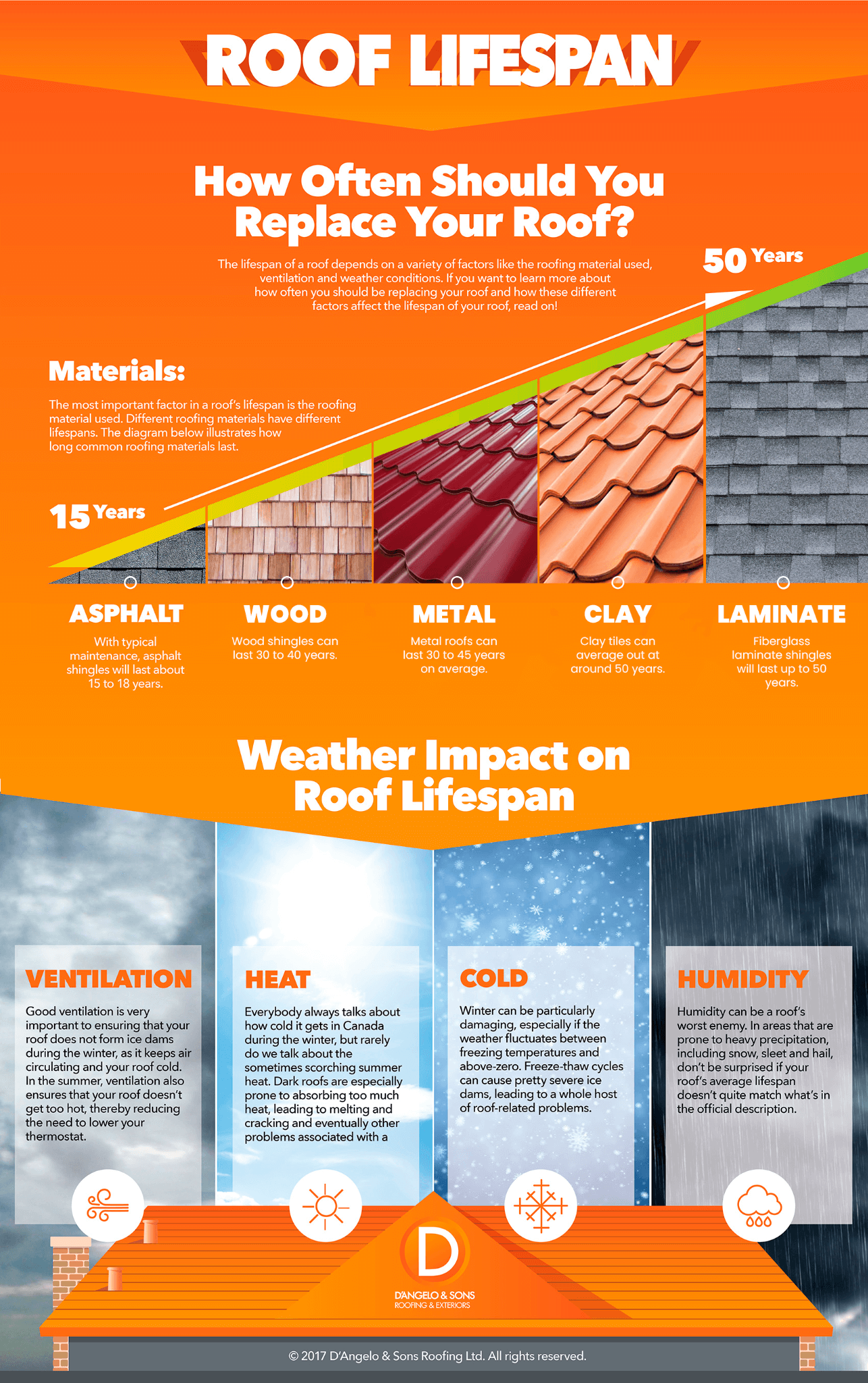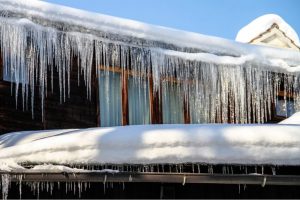How Often Should I Replace My Roof?
Aug 14, 2023

In this modern day and age, it seems like almost everything from cellphones to new cars are designed to be thrown out or replaced after just a few years. While this might not be a bad thing as far as technology is concerned, most homeowners very often focus on custom home renovations, but sometimes don’t want to invest in a roof that needs to be repaired or replaced as often as a trend-obsessed teenager’s smartphone.
How often should you replace your roof?
An average roof needs to be replaced after 15-50 years, depending on the material used, ventilation and climate factors like humidity, heat and cold. You should get a roofing contractor to perform a roof inspection every year to see what condition your roof is in and tell you if it needs to be replaced.
If you want to learn more about how often you should be replacing your roof, and how to maintain it, read on!
What is the average lifespan of a roof?
If you walk through any neighborhood, it might occur to you that most people’s houses have roofs that typically look the same. However, a roof’s lifespan can vary wildly from house to house, no matter how similar the appearance. Many factors can determine just how long a roof will last. Here are a few typical factors to consider:
Average Lifespan of a Roofing Material
Asphalt Shingles
Asphalt shingles have a lifespan that ranges from 15 to 20 years. However, some types, such as architectural asphalt, are superior and will last longer. Their ability to withstand harsh weather conditions can give them an additional 10 years compared to 3-tab shingles.
Clay/Cement Tile Roofing
Concrete or clay tiles are some of the most durable roofing materials in the current market because they can withstand natural elements without wearing off easily. On the downside, they are very heavy, which makes installation a little challenging. It also means the roof must be reinforced before the installation of the tiles.
However, the additional sturdiness helps protect the roof further. Their lifespan ranges between 50 to 100 years.
Slate Roofing
Slate roofing is the most long-lasting option out of all roofing types. It can go up to 125 years without needing replacement. If climatic conditions are adverse, the slate will last 100 years.
Wood Shingles
If you have wood shingles, expect them to last for at least 15 years and at most 30 years. The longevity will depend on the maintenance routines because these roofing materials cannot remain sturdy without being tended to. You have to clean the roof regularly to remove debris and moss that could accumulate moisture and cause the roof to decay. Wood shingles are also susceptible to fire damage.
With regular maintenance and fire-resistant coating, these roofing materials can last up to 50 years or more.
Wood Shakes
The main difference between wood shakes and shingles is thickness. Wood shakes are thicker and can withstand natural elements better than wood shingles, but they also require proper maintenance to remain durable.
Their average lifespan is 35 years, but you can get 5 more years if you take care of them properly.
Metal Roofing
Aluminum and steel are the most common metal roofing types, and they are the least durable out of all metal roofing types. They can last for 50 years with minimal to no maintenance. Other types like copper and zinc can go up to 100 years.
Factors That Affect Roof Lifespan
Some of the factors that affect the lifespan of a roof include the roof design, maintenance routines, existing damages on the roof, and climatic conditions. Wet weather can encourage mould growth on roofing shingles, while hot weather can cause the roofing materials to crack. In some cases, even when a lasting roof material like metal is used, extreme weather can still cause problems. Sealants applied on the roof may not prevent degradation. Some roofing materials are also lightweight and can easily get blown off the roof by the wind. Strong winds can also cause accidents like trees falling on the roof, causing extensive damages.
If any type of issue is left unrepaired on the roof for too long, no matter how minimal it may be, it will extend to other sections of the roof. For instance, a small crack can allow moisture to seep through and destroy the rest of the roof as the issue expands with time. Dealing with the problem as quickly as possible will make the roof last longer.
All these factors can be managed or prevented by having regular inspections of the roof. Regardless of the roofing material, inspecting and maintaining it appropriately will prolong its lifespan.
Material
Different roofing materials have different average lifespans. With typical roof maintenance, asphalt shingles will last about 15 to 18 years. Laminate shingles can do a bit better, averaging at about 24 to 30 years. Wood shingles and metal do quite well (30 to 40 years, and 30 to 45 years respectively), whereas clay tiles can average out at around 50 years.
If we’re talking commercial roofing, the materials used may include bitumen (10 to 16 years), single ply (15 to 25 years), EPDM (10 to 16 years) and concrete (35 to 50 years). There’s also hot mopping, with an average lifespan of 15 to 20 years. However, the latter is a very messy process and does emit toxic fumes.
Humidity
Humidity can be a roof’s worst enemy. In areas that are prone to heavy precipitation, including snow, sleet and hail, don’t be surprised if your roof’s average lifespan doesn’t quite match what’s in the official description. Winter can be particularly damaging, especially if the weather fluctuates between freezing temperatures and above-zero. Freeze-thaw cycles can cause pretty severe ice dams, leading to a whole host of roof-related problems.
Heat
Everybody always talks about how cold it gets in Canada during the winter, but rarely do we talk about the sometimes scorching summer heat. Dark roofs are especially prone to absorbing too much heat, leading to melting and cracking and eventually other problems associated with a vulnerable roof.
Poor ventilation
There’s more to a roof than the quality of the shingles or what have you. Good ventilation is very important to ensuring that your roof does not form ice dams during the winter, as it keeps air circulating and your roof cold. In the summer, ventilation also ensures that your roof doesn’t get too hot, thereby reducing the need to lower your thermostat.
Age
This is an obvious one, but the older your roof, the more likely it is to require a repair or even a replacement. While you might be in love with that refurbished heritage home with the great asking price, do your future self a favour by asking about roof inspections prior to purchasing a home.
If you know your roof is getting close to retirement time, call up your roofing company to see what can be done to safely prolong its lifespan. Even if you own a brand new home with a brand new roof, don’t neglect it over the years, or you might have to get those roofing contractors to put a new one in a lot sooner than you’d expected.
How often should my roof be replaced?
Despite knowing the average lifespan of your roofing material of choice, most roofs need to be replaced after about two decades of good use. Of course, if there are major issues, it might have to be done a lot sooner. Look for signs of severe damage, such as large water stains on your ceilings. Mold and other discolorations will also tip you off about excess moisture. A persistent leak can make for a seriously dangerous roof with structural problems, and may even put you at risk of a respiratory illness.
Signs of Roof Damage That Can Shorten the Life of Your Roof
o Holes and Leaks
Leaks on a roof are sometimes difficult to spot because they may originate from small hidden cracks. However, the longer the cracks go unnoticed or ignored, the bigger they become. The situation can escalate quickly, with moisture accumulating under the roofing shingles.
Small holes can also be difficult to identify, unlike bigger ones. If you can see the sun shining through the roof, you will have to work on repairing the hole as soon as possible. In some cases, you could end up changing the entire roof.
Inspect the roof through the attic and determine whether there are cracks or holes by checking for leaks when it rains and sun rays when it is shining. If you notice any sign, call a professional roofer immediately.
o Moisture and water stains/damage
If the attic has excess moisture, the roof is probably damaged. The same applies to stains on the ceiling or deck. These are indications that the roof is leaking and should be repaired soon. The insulation is another place that can show signs of water leaks. Check for pooling water or signs of soaking around the insulation.
The stains on surfaces can be yellowish, brown, or circular. They may also appear as streaks, especially on the walls. They are usually caused when debris mixes with rainwater.
Another sign of roof damage is sagging ceilings. If there is unevenness, call D’Angelo and Sons roofers immediately. Sagging is usually a sign that the problem has become too advanced.
o Exterior roof damage
While the above signs can be seen from inside the house, other signs of damage can only be seen from outside. Examples include decaying, cracking, or missing shingles. The section of the roof that has any of these problems will look out of place, making it easy to spot. Check for uniformity on the roof surface and call an expert to inspect the area you suspect has been damaged. Some of the external roof issues are caused by poor services from unqualified service providers, but they still need to be fixed.
In case you cannot reach the rooftop, look for pieces of shingles around the gutters. Other roofing materials like the flashing and chimney can also fall off when the roof has been damaged. Leaving them unattended will only cause more problems.
Repair or replace?
If your roof is damaged and you’re torn between repairing it or replacing it, this is a sign that you should probably call up a professional roofing company to get their consultation. A simple patch-up job shouldn’t leave you hemming and hawing – but as soon as you start to hesitate, your gut instinct may be trying to tell you something.
Replacing a couple shingles or dealing with a small animal-related problem may not warrant an entire roof-replacement, or even a partial one. On the other hand, if your roof is getting up there in years and you’re dealing with more than a few stray shingles, replacement may be the way to go.
A new roof is no joke, but having to do mid-sized roof repairs every year on an aging roof may in fact add up to the cost of a total replacement anyway. Partial replacement may not even be worth it either – the difference in cost between a full roof replacement and a partial one might add up to a few hundred. But if the that few hundred more means not having to undergo the process again with the other half of your roof a year or two down the line, a full replacement may just be worth it.
Talking about getting a whole new roof can seem pretty dramatic. If this isn’t something you want to even begin thinking about and you’re not dealing with an overly aged or damaged roof, pay close to attention to how you’re treating this very key feature of your home. Give it the love and care it needs, and you just may be able to maintain your roof’s lifespan beyond the average estimate, so long as luck is also on your side!
For more information, speak to a roofing contractor in your area. If you have any roofing questions you’d like to ask us please don’t hesitate to call us at (905) 387 3000 or contact us using the contact form on our website. We’d love to hear from you!






